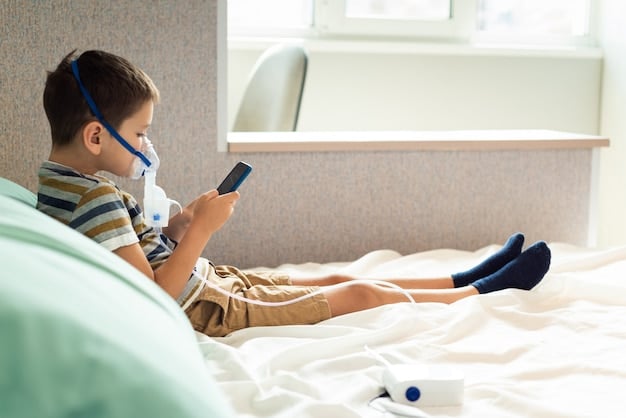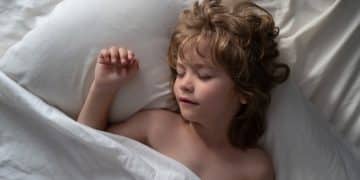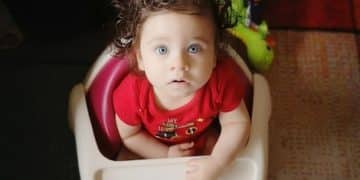Claim Up to $2,000 for Child’s Sleep Expenses in 2025: Financial Relief Guide

Financial relief opportunities exist for parents in the US who incur sleep-related medical expenses for their children, potentially allowing them to claim up to $2,000 in 2025 through specific tax deductions and healthcare spending accounts.
Struggling with your child’s sleep and the mounting medical bills? You might be eligible for financial relief: How to Claim Up to $2,000 in Sleep-Related Medical Expenses for Your Child in 2025. Let’s explore how.
Understanding Sleep-Related Medical Expenses
Dealing with a child’s sleep problems can lead to various medical expenses. Understanding which of these expenses qualify for financial relief is crucial for parents.
Sleep-related medical expenses encompass a range of costs associated with diagnosing and treating sleep disorders in children. These can include consultations with specialists, diagnostic tests, and prescribed treatments.
Common Sleep Disorders in Children
Several sleep disorders can affect children, leading to medical interventions. Early diagnosis and appropriate treatment are essential for their well-being.
- Sleep Apnea: Characterized by pauses in breathing during sleep, often requiring medical evaluation and intervention.
- Insomnia: Difficulty falling or staying asleep, which may necessitate behavioral therapy or, in some cases, medication.
- Restless Legs Syndrome (RLS): A neurological disorder causing an irresistible urge to move the legs, often disrupting sleep.
- Night Terrors: Episodes of screaming, intense fear, and flailing while still asleep.
Recognizing these disorders and seeking timely medical advice can improve a child’s sleep quality and potentially qualify related expenses for financial relief.

The expenses incurred for each sleep disorder can vary. It’s important to maintain accurate records of medical receipts, ensuring you meet the criteria for financial relief.
Navigating Tax Deductions for Medical Expenses
Tax deductions can provide financial relief for qualifying medical expenses. Understanding IRS guidelines is key to maximizing potential savings.
The IRS allows taxpayers to deduct medical expenses exceeding a certain percentage of their adjusted gross income (AGI). Keep detailed records to substantiate your claims.
Qualifying Medical Expenses
Not all medical expenses are deductible. It’s crucial to understand which costs meet the IRS criteria for deduction.
- Doctor Visits: Fees paid to physicians, specialists, and other healthcare providers.
- Diagnostic Tests: Costs associated with sleep studies, blood tests, and other diagnostic procedures.
- Prescription Medications: Expenses for prescribed drugs and medications to treat sleep disorders.
- Medical Equipment: Costs for medical devices like CPAP machines or specialized pillows, recommended by a physician.
Review IRS Publication 502 for comprehensive guidance on what qualifies as a deductible medical expense.
Ensure that you have proper documentation, such as receipts and doctor’s notes, to support your deductions. This will help prevent any issues during tax season.
Health Savings Accounts (HSAs) and Flexible Spending Accounts (FSAs)
Health Savings Accounts (HSAs) and Flexible Spending Accounts (FSAs) offer tax-advantaged ways to pay for medical expenses. Learn how these accounts can benefit you.
HSAs and FSAs allow individuals to set aside pre-tax funds for eligible healthcare costs. Properly utilizing these accounts can significantly reduce out-of-pocket expenses.
Benefits of HSAs and FSAs
Both HSAs and FSAs provide unique advantages for managing healthcare expenses. Choosing the right account depends on your individual circumstances.
- Tax Savings: Contributions are tax-deductible, earnings are tax-free, and withdrawals for qualified medical expenses are tax-free.
- Flexibility: Funds can be used for a wide range of medical expenses, including those related to sleep disorders.
- Portability: HSAs are typically portable, meaning you can take the account with you if you change jobs.
Consider consulting a financial advisor to determine whether an HSA or FSA is the best option for your family’s needs.

Understanding the rules and regulations of HSAs and FSAs ensures you maximize their benefits while remaining compliant with IRS guidelines.
Documenting Sleep-Related Expenses Effectively
Proper documentation is essential when claiming medical expenses. Accurate records can streamline the tax filing process and prevent potential issues.
Maintain detailed records of all sleep-related medical expenses, including receipts, invoices, and statements from healthcare providers. Organize these documents for easy access.
Tips for Effective Documentation
Implementing effective documentation practices can save time and reduce stress when filing taxes. Stay organized and keep accurate records.
- Keep Receipts: Save all receipts for doctor visits, diagnostic tests, medications, and medical equipment.
- Maintain a Log: Create a log or spreadsheet to track expenses, dates, and providers.
- Obtain Doctor’s Notes: Request notes from your child’s doctor outlining the medical necessity of treatments or equipment.
Regularly review and update your documentation to ensure accuracy and completeness. This will make tax preparation easier and more efficient.
Accurate documentation can significantly increase your chances of successfully claiming financial relief: How to Claim Up to $2,000 in Sleep-Related Medical Expenses for Your Child in 2025.
Strategies for Minimizing Sleep-Related Medical Costs
While seeking financial relief is important, minimizing sleep-related medical costs can provide additional financial benefits. Explore proactive strategies for cost management.
Consider various cost-saving strategies, such as seeking second opinions, comparing prices for medications, and exploring alternative treatment options.
Cost-Effective Strategies
Implementing practical strategies can help reduce the financial burden associated with sleep-related medical care. Be proactive and explore all available options.
- Compare Prices: Check prices for medications at different pharmacies to find the best deals.
- Seek Second Opinions: Obtain second opinions from different specialists to ensure accurate diagnoses and treatment plans.
- Explore Telemedicine: Consider telemedicine appointments for routine consultations, which can be more affordable than in-office visits.
By actively managing expenses, you can reduce the overall financial impact of your child’s sleep-related medical care.
Taking proactive steps to minimize costs can supplement any financial relief you receive, improving your family’s financial well-being.
Preparing for the 2025 Tax Year
Preparing for the 2025 tax year involves understanding the relevant tax laws and staying organized. Early preparation can streamline the filing process and maximize potential savings.
Start gathering necessary documents and familiarizing yourself with the latest tax regulations. Consult a tax professional for personalized advice.
Key Steps for Tax Preparation
Take these essential steps to prepare for the 2025 tax year and optimize your chances of receiving financial relief.
- Review IRS Publications: Stay updated on relevant IRS publications and guidelines.
- Gather Documentation: Collect all medical receipts, invoices, and statements.
- Consult a Tax Professional: Seek advice from a qualified tax advisor to ensure compliance and maximize deductions.
By planning ahead, you can avoid last-minute stress and confidently navigate the tax filing process.
Proper preparation is key to successfully claiming up to $2,000 in sleep-related medical expenses for your child in 2025, securing valuable financial relief.
| Key Aspect | Brief Description |
|---|---|
| 💰 Tax Deductions | Claim medical expenses exceeding a percentage of your AGI. |
| 🏥 HSAs/FSAs | Use health savings accounts for tax-advantaged medical payments. |
| 🧾 Documentation | Keep detailed records of medical expenses and doctor’s notes. |
| 😴 Sleep Disorders | Recognize common sleep disorders in children for eligible claims. |
Frequently Asked Questions (FAQ)
▼
Deductible medical expenses include doctor visits, diagnostic tests, prescription medications, and medical equipment necessary for treating medical conditions, including sleep disorders.
▼
Health Savings Accounts (HSAs) and Flexible Spending Accounts (FSAs) let you use pre-tax money for eligible sleep-related medical costs, reducing taxable income and out-of-pocket expenses.
▼
Keep receipts, invoices, and doctor’s statements for medical expenses. Include doctor’s notes if the medical necessity isn’t clear. This helps the IRS with verification.
▼
Compare prices for medications, seek second opinions from specialists, and try telemedicine for routine consultations to reduce healthcare costs. Always explore all options.
▼
Gather medical expense records, review the IRS’s Publication 502, and consult a tax professional for personalized advice to ensure all requirements are met and maximize claimable deductions.
Conclusion
Claiming up to $2,000 in sleep-related medical expenses for your child in 2025 requires careful planning and attention to detail. By understanding the available tax deductions, leveraging HSAs and FSAs, and maintaining thorough documentation, you can secure valuable financial relief and improve your family’s financial well-being.





